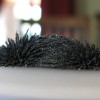Magnet Experiments: Iron Filings and Neodymium Magnets
Iron filings are, as their name suggests, filed pieces of iron that look like a metallic powder. Their properties are, in some aspects, similar to ferrofluid, because they form a significant pattern when interacting with a magnet. Magnetic fields are invisible, but the pattern that both substances form represents the lines of a magnetic field.
Pairing iron filings and magnets together is probably one of the most common, preliminary experiments used to show magnetism. Despite its commonality it is still an interesting way to display the magnetic field. Conduct your own experiment with iron filings and these simple steps!
Supplies
- Iron Filings
- White paper
- Magnet
Steps
- Place a piece of white paper on a flat surface.
- Pour some iron filings onto the center of the paper. Be careful when pouring them to avoid ingesting or breathing in powder from them. Also, leave enough space around the edges of the paper to allow you to pick it up without spilling its contents.
- Pick up the paper from the surface carefully. Take the magnet and place it between the paper and flat surface.
- You should see the iron filings spike up as the magnet nears the bottom of the paper. As you move the magnet around, the formation of the filings will change accordingly.
- The answer would be yes. Both the strength and shape of a magnet can affect the way the lines form.
- No, however, we can view the directions that they run with this experiment. You can view this neat film on invisible fields from NASA and Semiconductor Films for a deeper look into their mysterious nature.

